 Honda is the seventh-largest car maker in the world (in 2016). It is the largest maker of motor bikes and internal combustion engines overall. During my Grand Tour of Japanese Automotive, I was able to visit two of their plants: Sayama, where they produce cars, and Kumamoto, where they produce motor bikes and generators. These two plants are very different from each other. Let me give you what I found.
Honda is the seventh-largest car maker in the world (in 2016). It is the largest maker of motor bikes and internal combustion engines overall. During my Grand Tour of Japanese Automotive, I was able to visit two of their plants: Sayama, where they produce cars, and Kumamoto, where they produce motor bikes and generators. These two plants are very different from each other. Let me give you what I found.
Introduction
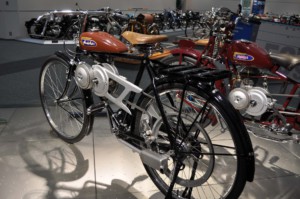
Honda is actually one of the youngest car makers in Japan, being founded after World War II in 1946 by Soichiro Honda (本田 宗一郎 1906–1991), who always seemed to have a big smile. Their philosophy is structured around respect for the individual and the “three joys“: The Joy of Buying, the Joy of Selling, and the Joy of Creating.
Their first products were motorcycles (actually motorized bicycles). By 1964 they were the largest motor bike manufacturer in the world. 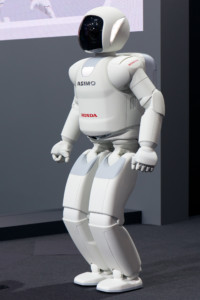 In 1953 they started to produce power equipment like lawn mowers, boat engines, or generators. In 1963 they expanded into automobiles, initially focusing on the small car segments, but introducing their own luxury brand Acura in 1986. They are also known for their Asimo robot, also starting in 1986. They produced aircraft engines since 1986, and their aircraft division had its first flight in 2003.
In 1953 they started to produce power equipment like lawn mowers, boat engines, or generators. In 1963 they expanded into automobiles, initially focusing on the small car segments, but introducing their own luxury brand Acura in 1986. They are also known for their Asimo robot, also starting in 1986. They produced aircraft engines since 1986, and their aircraft division had its first flight in 2003.
To be honest, to me it feels like too many different things (cars, motor bikes, aircraft, robots, boat engines, lawn mowers) … it is difficult to focus. From what I have seen, I believe their heart still beats for motorcycles, but with all the other products their focus gets diluted.
Saitama Sayama Plant (October 2017)
 The Saitama area has actually three plants, Sayama and Yorii for cars and Ogawa for engines. Yorii is the newest plant of the Honda group, whereas Sayama is the oldest one, dating to 1964. The plant is scheduled to be closed in 2022, with the employees being transferred to the new plant one hour away. However, this excuses only in part the unstructured and un-ergonomic conditions in the plant.
The Saitama area has actually three plants, Sayama and Yorii for cars and Ogawa for engines. Yorii is the newest plant of the Honda group, whereas Sayama is the oldest one, dating to 1964. The plant is scheduled to be closed in 2022, with the employees being transferred to the new plant one hour away. However, this excuses only in part the unstructured and un-ergonomic conditions in the plant.
Statistics
 The plant has a capacity of 1,050 cars per day, and produces 850 in average with 4,680 employees. They claim to have the fastest car assembly line in the world, but when I visited, their final assembly ran at a takt time of one car every sixty seconds, which is normal for automotive. Welding was slightly faster at forty seconds per body, but this is also common in industry. Besides, faster is not always better here. They work in two shifts between 6:30 AM and 11:30 PM, similar to its Kumamoto plant. The paint shop was the location where a generic car body was matched with a specific customer (or sales) order. The final assembly line used a batch size of around five for popular models and colors, but had occasionally the single odd-colored car with low demand in between (neon green, anyone?)
The plant has a capacity of 1,050 cars per day, and produces 850 in average with 4,680 employees. They claim to have the fastest car assembly line in the world, but when I visited, their final assembly ran at a takt time of one car every sixty seconds, which is normal for automotive. Welding was slightly faster at forty seconds per body, but this is also common in industry. Besides, faster is not always better here. They work in two shifts between 6:30 AM and 11:30 PM, similar to its Kumamoto plant. The paint shop was the location where a generic car body was matched with a specific customer (or sales) order. The final assembly line used a batch size of around five for popular models and colors, but had occasionally the single odd-colored car with low demand in between (neon green, anyone?)
Overall Impression
As I said above, I was not impressed. Not at all. For the usually good quality of Honda vehicles, I expected Toyota like-performance, but this was a disappointment. The plant was dark, dirty, and disorganized. Illumination was not good, and there were lots of dirty and dark corners. The employees at Honda wear white overalls to emphasize cleanliness, but at Sayama it was not working, and the overalls were often dirty too.
Information Flow
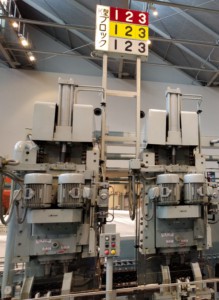
There was also very little information. There was no form of andon in the plant, except a single one at the final assembly, which also had an andon button to stop the line. When the welding line started beeping due to a problem, we could not see or figure out where or what was the issue; it just stopped and there was no light or anything indicating the location of the problem. We also could not figure out production quantities or if they were behind or ahead.
Material Flow
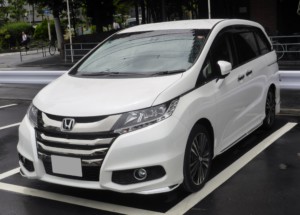
Ergonomics was also bad. Only some of the material was on an AGV, and employees were pushing heavy carts with a lot of effort along the paths. A lot of the transport was also by forklift, which usually indicates large quantities with little standardization. One employee was carrying large and unwieldy boxes through the plant.
Material supply was also a mess. They do not have a pull system, and also do not use kanban. The quantity of the material also by far exceeded the material around the Toyota assembly lines. For example, at the injection-molding location there was an inventory of around 3,600 panes, representing sixty hours or almost four days of work. This was an in-house operation close to the point of use, and could have been much better organized. Their seat supply, however, was Just in Time and Just in Sequence.
The oldest material notice I found dated from October 2015, two years ago. Material was just piled around the assembly lines. At one assembly station, I saw a shoebox-sized box of screws sitting alone on the floor, where the worker picked up the screws. This is neither ergonomic nor organized. Most material locations were not labeled or structured. There was little mechanical aid of any kind to help with the material supply at the line, and workers often had to bend or twist their bodies to get material. Heavy doors and seats were lifted out of a supply hanger by hand and carried to/in the car by hand.
Efficiency
Efficiency was also not impressive. At one station, a robot was attaching glue to a part, before an employee added some more glue (different type) to the same part. During a plant visit, I usually make a statistic on how many people are adding value when I see them versus how many are not adding value (waiting, walking, transporting, searching, etc.). Toyota is the best I have seen with 70% to 90% of the people adding value. The Honda Sayama plant is below average for car makers with people creating value for the customer less than 50% of the time.
People
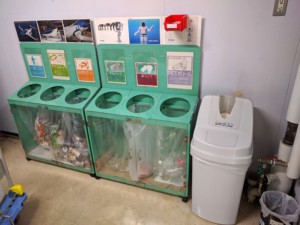 On the people side, they were nice and friendly. Honda seems to respect its workers. They also had the second-highest worker satisfaction on the Japanese employer reference and review site Vorkers with 3.81 (Toyota 4.9), and among the second-least overtime with only 22.7 hours per month in average (after Mazda with 22.4).
On the people side, they were nice and friendly. Honda seems to respect its workers. They also had the second-highest worker satisfaction on the Japanese employer reference and review site Vorkers with 3.81 (Toyota 4.9), and among the second-least overtime with only 22.7 hours per month in average (after Mazda with 22.4).
They also had the fanciest recycling I have seen in a long time, with a total of nine categories of waste.
If You Want to Follow in My Footsteps …
…then you would need to speak Japanese or at least have an interpreter, and be part of a larger group. You also need to apply two months beforehand through their website. In this case, you can enter a sort of lottery for the Sayama or Yorii plant for a plant tour. Their address is 1-10-1 Shinsayama, Sayama-shi, Saitama Pref. , Japan. Many thanks to Honda for the tour!
Summary
Overall, I was not impressed by the Sayama plant. Part of it can be explained by its age, another part by it being closed in 2022 (and who wants to invest time in a plant that will be closed anyway), but there was still enough left over to make this a pretty unimpressive plant. I went away with a pretty bad impression of Honda plants. Luckily, Honda Kumamoto was much, much better. More about this in the next post. In the meantime, go out and organize your industry!
Series Overview
- The Grand Tour of Japanese Automotive – Overview and Toyota
- The Grand Tour of Japanese Automotive – Nissan
- The Grand Tour of Japanese Automotive – Honda Sayama
- The Grand Tour of Japanese Automotive – Honda Kumamoto
- The Grand Tour of Japanese Automotive – Mitsubishi
- The Grand Tour of Japanese Automotive – Mazda
- The Grand Tour of Japanese Automotive – Suzuki
- The Grand Tour of Japanese Automotive – Subaru

This echoes what I saw 25 years ago. I was astonished to see components just stacked on the floor at trackside. In one building there was Body Assembly (welding) separated only by a gangway and plastic curtain from Trim. White overalls were white though, and staff all very friendly. I find this all quite astonishing!
I met someone (not at Honda) who said the founder boasted that he didn’t have a desk and office etc. and was proud of showing his ‘artisan’s hands’. Interestingly, I know of a British motorcycle manufacturer who started off as a tradesman (in another industry) who didn’t have an office either (he’d park himself wherever was available) and was also extremely suspicious of what might be broadly regarded as ‘scientific management’, but admiring of hard work, sweat on brow etc.
Very interesting observations. Thanks for sharing. I think Honda Motors has a unique history. It was founded by two persons Soichiro Honda and Takeo Fujisawa. They were completing each other, one in charge of R&D and manufacturing the other for the business side. They even retired from the company together. Actually there would be no Honda as we know it today if it wasn’t Takeo Fujisawa. Their story is very inspirational.
Your observations show once again that not all Japanese companies are like Toyota and have their mindset and matured efficient Production (Management) System.
https://www.youtube.com/watch?v=DQO4EgoPTBI
video of sayama plant – they make quality cars. ok old but i worked in Renault Belgium and that was also an old factory